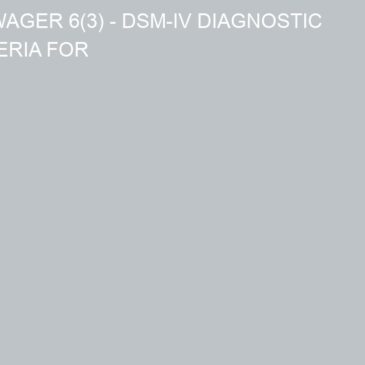Recently, we used the WAGER website’s relatively new search engine to investigate for information pertaining to the Diagnostic and Statistical Manual of Mental Disorders (DSM-IV) criteria for
pathological gambling. From a total of more than 250 WAGER issues, this search yielded 223 WAGERs that mentioned DSM-IV.
In many of these 223 WAGERs, ranging in topic from pathological gamblers and their income taxes to the prevalence of problem gambling in Great Britain, the DSM-IV criteria for pathological gambling was cited.
Indeed, gambling researchers and WAGER editors alike commonly cite these criteria. However, rarely are the criteria displayed in entirety. Since the American Psychiatric Association recently released a revision of DSM-IV (i.e., DSM-IV-TR), it is timely to revisit DSM-IV and present the criteria in full. Moreover, while investigators continue to use these parameters to guide the collection and analysis of their data, there remain increasing criticisms about weaknesses with the DSM-IV (e.g., Barron, 1998).
DSM-IV Diagnostic Criteria for Pathological Gambling
A. Persistent and recurrent maladaptive gambling behavior as indicated by five (or more) of the following:
- is preoccupied with gambling (e.g., is preoccupied with reliving past gambling experiences, handicapping or planning the next venture, or thinking of ways to get money with which to gamble)
- needs to gamble with increasing amounts of money in order to achieve the desired excitement
- has repeated unsuccessful efforts to control, cut back, or stop gambling
- is restless or irritable when attempting to cut down or stop gambling
- gambles as a way of escaping from problems or of relieving a dysphonic mood (e.g., feelings of helplessness, guilt, anxiety, depression)
- after losing money gambling, often returns another day to get even ("chasing" one’s losses)
- lies to family members, therapists, or others to conceal the extent of involvement with gambling
- has committed illegal acts such as forgery, fraud, theft, or embezzlement to finance gambling.
- has jeopardized or lost a significant relationship, job, or educational or career opportunity because of gambling
- relies on others to provide money to relieve a desperate financial situation caused by gambling
B. The gambling behavior is not better accounted for by a Manic Episode.
While the contributions made by DSM-IV’s criteria for pathological gambling to gambling-related research are immeasurable, the tool itself is sometimes uncertain. For example, DSM-IV differentiates between social gambling and pathological gambling. Social gambling is defined as that which "typically occurs with friends or colleagues and lasts for a limited period of time, with predetermined acceptable losses" (APA, p. 673, 2000). However, despite such a strict definition, it remains plausible that a social gambler might meet at least five of the criterion for pathological gambling (e.g., Criterion A1, A3, A4, A5, & A6). Indeed, a social gambler can limit gambling time and commit to "acceptable" losses and still remain preoccupied with gambling; relying on it as an escape from weekly stressors while remaining unsuccessful in efforts to cut back-which can breed restlessness and irritability-as the result of a desire to "break even" proceeding a less than successful gambling session.
In addition, Criterion A states that pathological gambling is identified by "…persistent and recurrent maladaptive gambling behavior as indicated by five or more…" (APA, p. 674, 2000) of the criterion listed. However, there is no discussion of the weight given to the severity of each criterion; similarly, there is no mention of the relationships that might exist among various criteria. In other words, if someone presents with eight of the ten criterion for pathological gambling, is their diagnosis more or less problematic compared with someone who presents meeting only four criteria, even if one of these four is so significant that it problematically supercedes all other criteria (i.e., criterion A3)? Indeed, researchers such as Radden (1995) address such psychiatric nosology issues, and further cite a growing unease associated with DSM-IV in terms of its susceptibility to yield misleading results if singularly applied to all clinical and research populations.
Nevertheless, the DSM-IV, in its entirety and specifically its criteria for pathological gambling, remains an invaluable tool for both the scientific community and the public at-large. In addition, a careful reading of DSM-IV should remind clinicians that there is discretion to be used with this diagnostic tool when they evaluate problem and pathological gamblers. Also, a careful reading of DSM-IV by the public at-large can enhance their understanding about pathological gambling and the clinical manifestations this disorder is likely to present.
References
Barron, J. (Ed.). (1998). Making diagnosis meaningful: enhancing evaluation and treatment of psychological disorders. Washington, D.C.: American Psychological Association.
Diagnostic and Statistical Manual of Mental Disorders (Fourth ed.) (2000). Washington, DC: American Psychiatric Association.
Radden, J. (1995). Recent criticism of psychiatric nosology: A review. Philosophy, Psychiatry, and Psychology, 1(3), 193-200.




